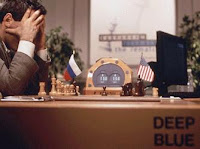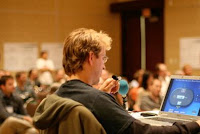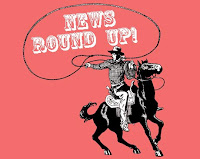Salinger’s Game of Solitaire
 J.D. Salinger died on Wednesday at age 91. Been a while since we’d heard from him.
J.D. Salinger died on Wednesday at age 91. Been a while since we’d heard from him. Been a while also since I’d thought much about Salinger. Like most, I encountered The Catcher in the Rye as a young person, and like some I went on to read Nine Stories and everything else I could find. As a teen I suppose I identified somewhat with Holden Caulfield’s frustration. And puzzled over Seymour’s suicide in “A Perfect Day for Bananafish.”
But like I say, haven’t thought much about Salinger since, other than occasionally to wonder what he’s been up to, and whether he ever wrote anything again since 1965 when the last story of his to appear in print -- the lengthy “Hapworth 16, 1924” -- was published in The New Yorker. Perhaps now that he’s gone, we may find out more about what he’s exactly been up to these last 45 years. (Or not.)
Many have speculated about why Salinger -- once a genuine literary celebrity, famous not just in academic circles but well beyond -- stopped publishing and so thoroughly withdrew from the public eye. One oft-repeated story, appearing in The New York Times article from yesterday about Salinger’s death, concerns him having been interviewed by some high school students for what he thought was going to be an innocuous piece in the local paper. The interview wound up on the editorial page (not on the high school news page), and Salinger apparently was so upset he soon began refusing interview requests.
He also built a six-and-a-half foot fence around his property.
Publishing is a tricky business. One never knows exactly how others are going to receive your words and ideas. As in poker, there’s always an element of risk that must be weighed against whatever reward may come from putting yourself “out there.”
Just so happens that on Wednesday -- the day I wrote about driving a lot -- I was in the car listening to a National Public Radio segment that had to do with blogging and the way one potentially loses control of one’s message when putting one’s words and ideas on these here intertubes.
The story was about the Pope who is apparently considering whether or not to start some sort of blog. A few experts were asked for their thoughts, and there was some funny, irreverent humor in there with people giving the Pope advice about the need to blog every day, to use hot links (not footnotes), and so forth.
One such expert, David Weinberger (a technology pundit and blogger), came on to address this issue of what happens when one publishes online. “Putting a message out on the internet is exactly the same thing as losing total control of your message,” said Weinberger. “People take it up, they republish it, they make fun of it, they contextualize it, [and] the simple message becomes incredibly complex.”
As if to confirm what Weinberger was saying, there was another story about Apple announcing its new iPad in which the reporters noted that there probably weren’t any women involved in the naming of the new tablet computer. Without being specific, they were alluding to the instantaneous reaction on the internet to the name “iPad” which saw some associate it with a woman’s product. (Some may have noticed that “iTampon” became a “trending topic” on Twitter within an hour of Apple’s announcement.) I suppose you could call that another example of having (somewhat) lost control of the message, with the speed of the ’net significantly accelerating that process.
I’ve been well aware for a long time how keeping a blog -- or writing and publishing, generally speaking -- necessarily involves “losing total control” of one’s message. But really, who wants “total control”? If, that is, these are indeed “messages” we are delivering, with a hope that those messages might be heard and perhaps responded to in some fashion, and not just “broadcasts” (or sermons?) for which we neither expect or desire feedback.
No, publishing means being willing to share the “control” over one’s messages. Otherwise we’re just talking to ourselves. Like playing solitaire -- no risk of losing, but not much to gain, either.
In a rare interview from 1974, Salinger told a reporter of how content he was not to be publishing. “It’s peaceful. Still. Publishing is a terrible invasion of my privacy. I like to write. I love to write. But I write just for myself and my own pleasure.”
I can respect that, but that’s about all I have to say about it. Not much one can say in response to someone who prefers sitting out to playing.
Labels: *by the book, blogging, J.D. Salinger








 and only the blinds really to worry about, and so shoved to isolate. Small blind -- whom I had covered -- pushed all in, too, and the shorty skedaddled. My opponent has me dominated with A-K. Board ran out eight-high, and I’m now down to 2,705. Still 27 big blinds, though, so no worries quite yet.
and only the blinds really to worry about, and so shoved to isolate. Small blind -- whom I had covered -- pushed all in, too, and the shorty skedaddled. My opponent has me dominated with A-K. Board ran out eight-high, and I’m now down to 2,705. Still 27 big blinds, though, so no worries quite yet.
 . Folded around to the big blind who thought a long while, then called with
. Folded around to the big blind who thought a long while, then called with  . The flop was a nice one:
. The flop was a nice one: 

 . I liked the turn, too --
. I liked the turn, too --  . But you know what's coming... the
. But you know what's coming... the  on the river. Rude! And I’m outta there in six-hundred-and-somethingth, just as the last song of Beacons of Ancestorship was finishing for the second time this afternoon.
on the river. Rude! And I’m outta there in six-hundred-and-somethingth, just as the last song of Beacons of Ancestorship was finishing for the second time this afternoon. 











 . Drifter23 checked, and RowdyRon bet $2.50 -- about half the pot. Drifter23 then check-raised pot to $11.35, and after thinking for a while RowdyRon finally folded, conceding the $8.65 pot to Drifter23.
. Drifter23 checked, and RowdyRon bet $2.50 -- about half the pot. Drifter23 then check-raised pot to $11.35, and after thinking for a while RowdyRon finally folded, conceding the $8.65 pot to Drifter23.



















